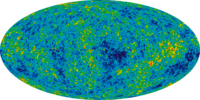
Photo from wikipedia
In experiments searching for axionic dark matter, the use of the standard threshold-based data analysis discards valuable information. We present a Bayesian analysis framework that builds on an existing processing… Click to show full abstract
In experiments searching for axionic dark matter, the use of the standard threshold-based data analysis discards valuable information. We present a Bayesian analysis framework that builds on an existing processing protocol [B. M. Brubaker, L. Zhong, S. K. Lamoreaux, K. W. Lehnert, and K. A. van Bibber, Phys. Rev. D 96, 123008 (2017)] to extract more information from the data of coherent axion detectors such as operating haloscopes. The analysis avoids logical subtleties that accompany the standard analysis framework and enables greater experimental flexibility on future data runs. Performing this analysis on the existing data from the HAYSTAC experiment, we find improved constraints on the axion-photon coupling ${g}_{\ensuremath{\gamma}}$ while also identifying the most promising regions of parameter space within the $23.15--24.0\text{ }\text{ }\ensuremath{\mu}\mathrm{eV}$ mass range. A comparison with the standard threshold analysis suggests a 36% improvement in scan rate from our analysis, demonstrating the utility of this framework for future axion haloscope analyses.
Journal Title: Physical Review D
Year Published: 2020
Link to full text (if available)
Share on Social Media: Sign Up to like & get
recommendations!